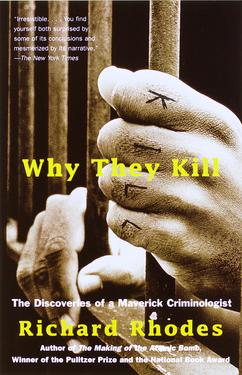- Welcome to FictionDB, Guest
- | My Account
- | Help

Why They Kill — Richard Rhodes
Why do some men, women and even children assault, batter, rape, mutilate and murder? In his stunning new book, the Pulitzer Prize-winner Richard Rhodes provides a startling and persuasive answer.
Why They Killexplores the discoveries of a maverick American criminologist, Dr. Lonnie Athens -- himself the child of a violent family -- which challenge conventional theories about violent behavior. By interviewing violent criminals in prison, Dr. Athens has identified a pattern of social development common to all seriously violent people -- a four-stage process he calls "violentization":
-- First, brutalization: A young person is forced by violence or the threat of violence to submit to an aggressive authority figure; he witnesses the violent subjugation of intimates, and the authority figure coaches him to use violence to settle disputes.
-- Second, belligerency: The dispirited subject, determined to prevent his further violent subjugation, heeds his coach and resolves to resort to violence.
-- Third, violent performances: His violent response to provocation succeeds, and he reads respect and fear in the eyes of others.
-- Fourth, virulency: Exultant, he determines from now on to utilize serious violence as a means of dealing with people -- and he bonds with others who believe as he does.
Since all four stages must be fully experienced in sequence and completed to produce a violent individual, we see how intervening to interrupt the process can prevent a tragic outcome.
Rhodes supports Athens's theory with historical evidence and shows how it explains such violent careers as those of Perry Smith (the killer central to Truman Capote's narrative In Cold Blood), Mike Tyson, "preppy rapist" Alex Kelly, and Lee Harvey Oswald.
Why They Kill challenges with devastating evidence the theory that violent behavior is impulsive, unconsciously motivated and predetermined. It offers compelling insights into the terrible, ongoing dilemma of criminal violence that plagues families, neighborhoods, cities and schools.
Why They Killexplores the discoveries of a maverick American criminologist, Dr. Lonnie Athens -- himself the child of a violent family -- which challenge conventional theories about violent behavior. By interviewing violent criminals in prison, Dr. Athens has identified a pattern of social development common to all seriously violent people -- a four-stage process he calls "violentization":
-- First, brutalization: A young person is forced by violence or the threat of violence to submit to an aggressive authority figure; he witnesses the violent subjugation of intimates, and the authority figure coaches him to use violence to settle disputes.
-- Second, belligerency: The dispirited subject, determined to prevent his further violent subjugation, heeds his coach and resolves to resort to violence.
-- Third, violent performances: His violent response to provocation succeeds, and he reads respect and fear in the eyes of others.
-- Fourth, virulency: Exultant, he determines from now on to utilize serious violence as a means of dealing with people -- and he bonds with others who believe as he does.
Since all four stages must be fully experienced in sequence and completed to produce a violent individual, we see how intervening to interrupt the process can prevent a tragic outcome.
Rhodes supports Athens's theory with historical evidence and shows how it explains such violent careers as those of Perry Smith (the killer central to Truman Capote's narrative In Cold Blood), Mike Tyson, "preppy rapist" Alex Kelly, and Lee Harvey Oswald.
Why They Kill challenges with devastating evidence the theory that violent behavior is impulsive, unconsciously motivated and predetermined. It offers compelling insights into the terrible, ongoing dilemma of criminal violence that plagues families, neighborhoods, cities and schools.
Genres
Click on any of the links above to see more books like this one.

